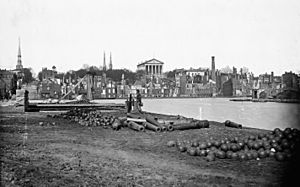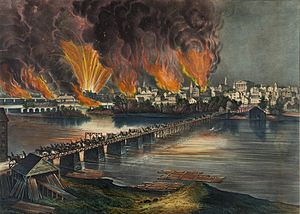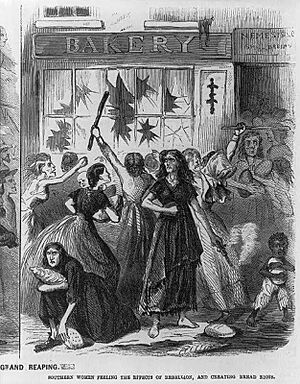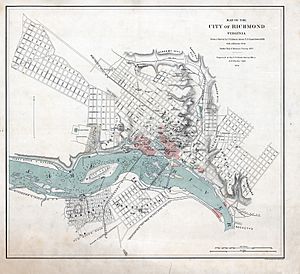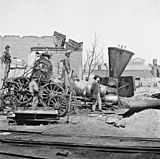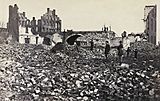Richmond in the American Civil War facts for kids
Richmond, Virginia was the capital city of the Confederate States of America for most of the American Civil War. It was a very important place for making weapons and supplies for the war. It was also a major hub where five different railroads met.
The Union army tried many times to capture Richmond. In 1862, during the Peninsula Campaign, General George McClellan led his troops close to the city. But he was stopped by General Robert E. Lee in the Seven Days Battles. Later, in 1864-1865, General U.S. Grant surrounded nearby Petersburg. By April 1865, the Confederate government knew they would soon be captured. They decided to leave Richmond. As they left, the Confederate soldiers burned military supplies so the Union army couldn't use them. This fire spread and destroyed a large part of central Richmond.
Contents
Richmond's Importance in the Civil War
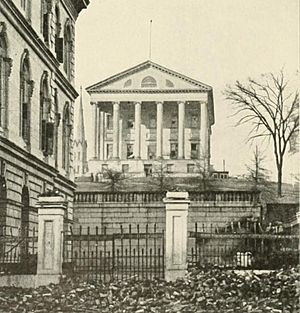
In 1860, Richmond was one of the biggest cities in the United States. It had about 37,910 people. The city had been the capital of Virginia since 1780. During the Civil War, it became the third-largest city in the Confederacy.
Why Richmond Became the Confederate Capital
The Confederate States of America was formed in early 1861. At first, their capital was in Montgomery, Alabama.
The Civil War began on April 12, 1861, when Confederate soldiers fired on Fort Sumter. Soon after, more states joined the Confederacy. Virginia decided to leave the Union on April 17, 1861. Because Virginia was so important, the Confederacy decided to move its capital to Richmond. This happened on May 8, 1861. Virginia was a key state for the South. It had many factories, making almost as many goods as all other Confederate states combined. Moving the capital also helped the Confederacy control Virginia better.
The Seal of the Confederate States, created in 1863, showed George Washington. This image was based on a statue near the Confederate Capitol building in Richmond.
Richmond stayed the Confederate capital until April 2, 1865. Then, the government left and briefly moved to Danville, Virginia.
Richmond's Factories and Transportation
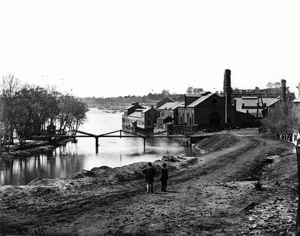
Richmond was built along the James River. This location gave the city plenty of hydropower to run its mills and factories.
The Tredegar Iron Works was a huge factory next to the James River. It made high-quality weapons for the Confederacy during the war. This company also built railroad trains. Tredegar made about 10,000 cannons during the war. This was about half of all the cannons made in the South from 1861 to 1865. The factory also made the heavy armor for the CSS Virginia, a famous ironclad ship. This ship fought in the first battle between ironclad warships in March 1862. Next to Tredegar was the Richmond Arsenal, another important weapon-making site. On Brown's Island, a special lab was set up to make explosives. This was done in an isolated spot in case of an accident.
Many smaller factories in Richmond made other war supplies. These included tents, uniforms, harnesses, leather goods, swords, and bayonets. As the war continued, Richmond's warehouses became the main supply center for Confederate forces in the eastern part of the war.
Richmond was also a major transportation hub. Five different railroads ended in the city. These were the Richmond, Fredericksburg, and Potomac; the Virginia Central; the Richmond and York River; the Richmond and Petersburg; and the Richmond and Danville railroads. The James River and Kanawha Canal also ran through Richmond. This canal connected to the Chesapeake Bay and the Atlantic Ocean. By the time Richmond fell in April 1865, most of these routes were cut off by Union forces. Only the Richmond and Danville Railroad and the canal were still open.
Union Attempts to Capture Richmond
In the spring of 1862, a large Union army landed on the Virginia Peninsula. Major General George B. McClellan was in charge of capturing Richmond. His army's movements and the battles that followed are known as the Peninsula Campaign. This campaign ended with the Seven Days Battles.
McClellan's army started from Fort Monroe, a Union-held fort. Confederate defenses stopped Union ships from moving up the James River at the Battle of Drewry's Bluff on May 15. This battle was about eight miles from Richmond. The Union army's advance on land was also stopped just outside the city at the Battle of Seven Pines on May 31 and June 1, 1862.
The Seven Days Battles
From June 25 to July 1, 1862, a series of battles took place. General Robert E. Lee had set up strong defenses around Richmond. Confederate cavalry, led by General J.E.B. Stuart, rode all the way around the Union army. Also, General Stonewall Jackson's famous "foot cavalry" arrived unexpectedly. All these events made General McClellan nervous. He decided to retreat before reaching Richmond.
The failure of the Peninsula Campaign to capture Richmond meant the war continued for almost three more years.
Life in Richmond During the War
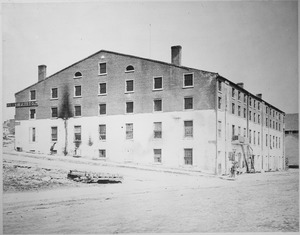
Because Richmond was close to many battlefields, it handled many wounded soldiers from both sides. The city had many hospitals, with Chimborazo Hospital being the largest. It also had several prisons, like Libby Prison, Castle Thunder, and Belle Isle. Many soldiers were buried in the city's cemeteries.
On March 13, 1863, an explosion at the Confederate Laboratory on Brown's Island killed many workers.
On April 2, 1863, Richmond faced a big bread riot. Housewives were angry because food prices were too high. They broke into stores to get food. The riot was led by Mary Jackson. The city's militia had to be called in to stop the riot.
The Confederacy had its greatest success at the Battle of Gettysburg in July 1863. After that, no major decisive battles happened for a while. People in Richmond remained hopeful about the Confederacy's chances during the winter of 1863-1864.
One of the most daring prison escapes of the war happened in February 1864. More than 100 Union prisoners escaped from Libby Prison. Less than half were caught, and most reached Union lines safely. Soon after, on March 2, 1864, a Union raid on the city called the Dahlgren affair failed.
In 1864, Ulysses S. Grant's Overland Campaign pushed Robert E. Lee's Confederate army back to Richmond and Petersburg. There, they stopped Grant's advance.
The Fall of Richmond and the Great Fire
After a long siege, General Grant captured Petersburg and Richmond in early April 1865. On April 2, 1865, known as Evacuation Sunday, President Davis, his government, and the Confederate soldiers left Richmond. They fled south on the last open railroad line.
The retreating soldiers were told to burn bridges, the armory, and supply warehouses. But the fire in the mostly empty city spread out of control. Large parts of Richmond were destroyed, reaching almost to the Capitol Square. The fire was not fully put out until the mayor and other citizens went to the Union lines and surrendered the city the next day. Union troops then helped to put out the huge fires. This event became known as the Evacuation Fire. General Godfrey Weitzel and later General Edward Ord oversaw the occupation of the city.
President Abraham Lincoln visited General Grant nearby. He then toured the fallen city from April 4-7. He walked and rode in a carriage with his young son Tad. He also visited the former White House of the Confederacy and the Virginia State Capitol.
About a week after Richmond was evacuated, General Robert E. Lee surrendered to Grant on April 9. This ended the Battle of Appomattox Courthouse. In the same week, on April 14, President Lincoln was assassinated in Washington D.C. by John Wilkes Booth.
- Damage from the Evacuation Fire
-
Remains of a train from the Richmond and Petersburg Railroad
Richmond's Civil War Legacy
Hollywood Cemetery in Richmond is the burial place for many important Civil War figures. These include Jefferson Davis, General Stuart, and other Confederate generals. A large stone pyramid stands in the section where over 18,000 Confederate soldiers are buried. Many of these soldiers are unknown.
Other war dead were buried at Oakwood Cemetery, Shockoe Hill Cemetery, and the Cemetery for Hebrew Confederate Soldiers. Many Union soldiers buried in these places were later moved to national cemeteries outside the city.
Richmond used to have many markers and monuments remembering the Civil War. Monument Avenue was created in 1887. It had a series of monuments honoring Confederate heroes at different intersections. These included statues of J.E.B. Stuart, Robert E. Lee, Jefferson Davis, Stonewall Jackson, and Matthew F. Maury.
The Richmond National Battlefield Park is part of the National Park Service. It protects several battlefields from the Peninsula Campaign and other battles. You can take a driving tour through Civil War sites in Richmond. The White House of the Confederacy has been fully restored to how it looked during the war. It is open for tours. Next door, the Museum of the Confederacy has the largest collection of items related to the Confederacy. Other museums include the Virginia Historical Society. A statue of Lincoln was put up in 2003, which caused some debate.
Richmond in Popular Culture
The Charlie Daniels Band song "Trudy" talks about winning big. It says the narrator was "raking in chips like Grant took Richmond" in a poker game.
In 1969, The Band released the song "The Night They Drove Old Dixie Down". It includes the line, "...by May the 10th (1865) Richmond had fell, it was a time I remember oh so well." On May 10, 1865, Confederate President Jefferson Davis was captured by Union forces in Georgia.
The punk band Love Roses, from Richmond, used a famous picture of the city burning on the cover of their album "A New Reason for the Same Old Mistakes."


